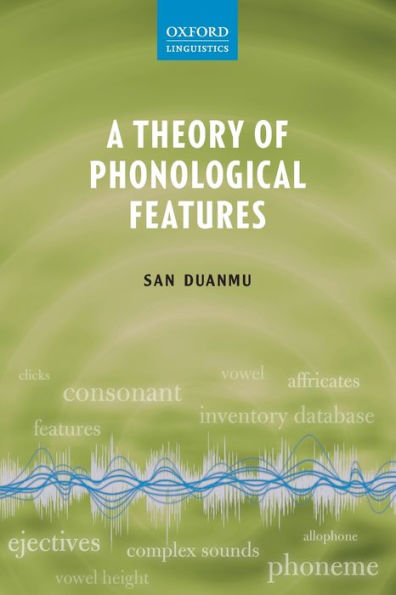A Theory of Phonological Features
This book outlines a system of phonological features that is minimally sufficient to distinguish all consonants and vowels in the languages of the world. The extensive evidence is drawn from datasets with a combined total of about 1000 sound inventories.
The interpretation of phonetic transcriptions from different languages is a long-standing problem. In this book, San Duanmu proposes a solution that relies on the notion of contrast: X and Y are different sounds if and only if they contrast in some language. He focuses on a simple procedure to interpret empirical data: for each phonetic dimension, all inventories are searched in order to determine the maximal number of contrasts required. In addition, every unusual feature or extra degree of contrast is re-examined to confirm its validity. The resulting feature system is surprisingly simple: fewer features are needed than previously proposed, and for each feature, a two-way contrast is sufficient. Nevertheless, the proposal is reliable in that the notion of contrast is uncontroversial, the procedure is explicit, and the result is repeatable. The book also offers discussion of non-contrastive differences between languages, sound classes, and complex sounds such as affricates, consonant-glide units, consonant-liquid units, contour tones, pre-nasalized stops, clicks, ejectives, and implosives.
1135176701
The interpretation of phonetic transcriptions from different languages is a long-standing problem. In this book, San Duanmu proposes a solution that relies on the notion of contrast: X and Y are different sounds if and only if they contrast in some language. He focuses on a simple procedure to interpret empirical data: for each phonetic dimension, all inventories are searched in order to determine the maximal number of contrasts required. In addition, every unusual feature or extra degree of contrast is re-examined to confirm its validity. The resulting feature system is surprisingly simple: fewer features are needed than previously proposed, and for each feature, a two-way contrast is sufficient. Nevertheless, the proposal is reliable in that the notion of contrast is uncontroversial, the procedure is explicit, and the result is repeatable. The book also offers discussion of non-contrastive differences between languages, sound classes, and complex sounds such as affricates, consonant-glide units, consonant-liquid units, contour tones, pre-nasalized stops, clicks, ejectives, and implosives.
A Theory of Phonological Features
This book outlines a system of phonological features that is minimally sufficient to distinguish all consonants and vowels in the languages of the world. The extensive evidence is drawn from datasets with a combined total of about 1000 sound inventories.
The interpretation of phonetic transcriptions from different languages is a long-standing problem. In this book, San Duanmu proposes a solution that relies on the notion of contrast: X and Y are different sounds if and only if they contrast in some language. He focuses on a simple procedure to interpret empirical data: for each phonetic dimension, all inventories are searched in order to determine the maximal number of contrasts required. In addition, every unusual feature or extra degree of contrast is re-examined to confirm its validity. The resulting feature system is surprisingly simple: fewer features are needed than previously proposed, and for each feature, a two-way contrast is sufficient. Nevertheless, the proposal is reliable in that the notion of contrast is uncontroversial, the procedure is explicit, and the result is repeatable. The book also offers discussion of non-contrastive differences between languages, sound classes, and complex sounds such as affricates, consonant-glide units, consonant-liquid units, contour tones, pre-nasalized stops, clicks, ejectives, and implosives.
The interpretation of phonetic transcriptions from different languages is a long-standing problem. In this book, San Duanmu proposes a solution that relies on the notion of contrast: X and Y are different sounds if and only if they contrast in some language. He focuses on a simple procedure to interpret empirical data: for each phonetic dimension, all inventories are searched in order to determine the maximal number of contrasts required. In addition, every unusual feature or extra degree of contrast is re-examined to confirm its validity. The resulting feature system is surprisingly simple: fewer features are needed than previously proposed, and for each feature, a two-way contrast is sufficient. Nevertheless, the proposal is reliable in that the notion of contrast is uncontroversial, the procedure is explicit, and the result is repeatable. The book also offers discussion of non-contrastive differences between languages, sound classes, and complex sounds such as affricates, consonant-glide units, consonant-liquid units, contour tones, pre-nasalized stops, clicks, ejectives, and implosives.
37.99
In Stock
5
1

A Theory of Phonological Features
192
A Theory of Phonological Features
192Paperback
$37.99
37.99
In Stock

Product Details
| ISBN-13: | 9780199664979 |
|---|---|
| Publisher: | Oxford University Press |
| Publication date: | 12/15/2019 |
| Pages: | 192 |
| Product dimensions: | 9.10(w) x 6.10(h) x 0.50(d) |
About the Author
From the B&N Reads Blog
